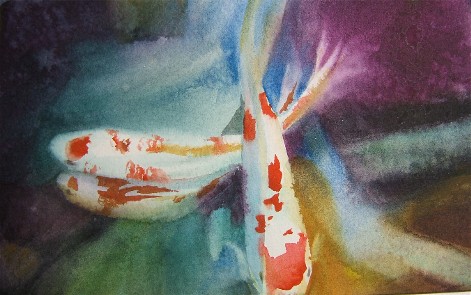 Art is usually divided in the main categories "abstract" or "realistic". But the difference between abstract and realistic painting techniques shouldn't be absolute. As long as abstract is just abstract and realistic just realistic, there's no movement or development. Painting becomes interesting right where abstract and realistic painting meet. Realistic paintings are immersed with abstract aspects like color, composition, forms and texture - and abstract paintings that are really only abstract don't mean anything to a human anymore. Good abstract art always has some (new and creative) referral to our memory of sensory perception.
Art is usually divided in the main categories "abstract" or "realistic". But the difference between abstract and realistic painting techniques shouldn't be absolute. As long as abstract is just abstract and realistic just realistic, there's no movement or development. Painting becomes interesting right where abstract and realistic painting meet. Realistic paintings are immersed with abstract aspects like color, composition, forms and texture - and abstract paintings that are really only abstract don't mean anything to a human anymore. Good abstract art always has some (new and creative) referral to our memory of sensory perception. When you paint realistic, you need some abstract skills to make good paintings. With an eye for color, composition and form, you can analyze your painting, gain some visual distance to it. That enables you to improve your painting. And in abstract painting, you also need to have some realistic painting skills. The best abstract painters were those, who had an old fashioned training in realistic oil painting techniques.
When you paint realistic, you need some abstract skills to make good paintings. With an eye for color, composition and form, you can analyze your painting, gain some visual distance to it. That enables you to improve your painting. And in abstract painting, you also need to have some realistic painting skills. The best abstract painters were those, who had an old fashioned training in realistic oil painting techniques. Even when we make photo's, we don't depict reality or nature 'as it really is'. We choose subjects, lighting, a composition. The same thing happens when we make realistic paintings. The sky is blue and trees are green - in our minds - but a closer look shows that things can have all kinds of colors, and that you can play with the mood of picture by choosing specific subjects, props, or a specific time of the day. This goes even more in realistic painting - you build up all the visual elements yourself.
Even when we make photo's, we don't depict reality or nature 'as it really is'. We choose subjects, lighting, a composition. The same thing happens when we make realistic paintings. The sky is blue and trees are green - in our minds - but a closer look shows that things can have all kinds of colors, and that you can play with the mood of picture by choosing specific subjects, props, or a specific time of the day. This goes even more in realistic painting - you build up all the visual elements yourself. In abstract painting, there is no absolute 'abstractness' either. Even the square of Malevitsch makes some reference to certain crystal shapes, to furniture, to things on earth.
In abstract painting, there is no absolute 'abstractness' either. Even the square of Malevitsch makes some reference to certain crystal shapes, to furniture, to things on earth. When we make abstract paintings, there are always elements present that refer to reality, or, our experiences as sentient beings. "up" and "down" are general terms, but they have specific meanings - "down"you expect to find a bottom, something solid, to stand on, and "up" you expect air, and some light. That would be a natural situation. It can be the other way around, of course, but then you have quite a different mood (the perspective of someone hanging from a cliff, staring in a void down below - very stressfull)
When we make abstract paintings, there are always elements present that refer to reality, or, our experiences as sentient beings. "up" and "down" are general terms, but they have specific meanings - "down"you expect to find a bottom, something solid, to stand on, and "up" you expect air, and some light. That would be a natural situation. It can be the other way around, of course, but then you have quite a different mood (the perspective of someone hanging from a cliff, staring in a void down below - very stressfull)Every visual element - color, form, proportions - refers to something. Red is a fruit color, a color of passion, and blue is a sky-color, a distance-color. Painting a red sky creates drama. And painting blue food creates an alienated, distant and unnatural look. When you take this knowledge into abstract painting, you can make use your work to communicate meaning.
No comments:
Post a Comment